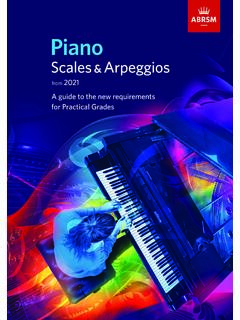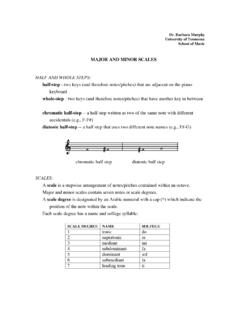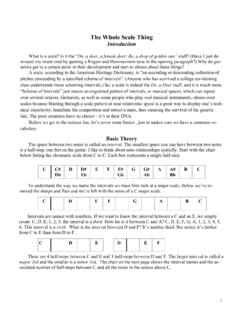Transcription of ABRSM Piano Syllabus 2021 & 2022
1 33 Practical Grades (updated September 2020) Piano 2021 & 2022 GRADE 7 PREREQUISITE FOR ENTRY: ABRSM Grade 5 (or above) in Music Theory, Practical Musicianship or a Practical Grades solo Jazz instrument. For alternatives, see PIECES: one chosen by the candidate from each of the three Lists, A, B and C; for further details see pages 13 14 COMPOSERPIECE / WORK / ARRANGERPUBLICATION (PUBLISHER)1J. S. BachSinfonia in B minor , BWV 801 Piano Exam Pieces 2021 & 2022, Grade 7 ( ABRSM )2 BeethovenBagatelle in E- (No. 1 from Seven Bagatelles, Op. 33) Piano Exam Pieces 2021 & 2022, Grade 7 ( ABRSM )3 TelemannVivace (1st movt from Fantasia in G minor , TWV 33:8) Piano Exam Pieces 2021 & 2022, Grade 7 ( ABRSM )4C. P. E. BachAllegro di molto (1st movt from Sonata in F minor , Wq. 63/6)Pp. 40 43 from C. P. E. Bach: Selected Keyboard Works, Book 4 ( ABRSM )5 HaydnModerato (1st movt from Sonata in E, Hob. XVI:31)Haydn: Selected Keyboard Sonatas, Book 3 ( ABRSM ) or Haydn: Complete Piano Sonatas, Vol.
2 3 (Wiener Urtext)6 KuhlauAllegro con spirito (1st movt from Sonatina in A, Op. 60 No. 2)Kuhlau: Sonatinas, Vol. 2 (Peters)7 MozartGigue in G, K. 574Pp. 11 12 from A Keyboard Anthology, 2nd Series, Book 5 ( ABRSM ) or Mozart: Mature Piano Pieces ( ABRSM ) or Mozart: Piano Pieces, Selection (Henle)8 ParadiesAllegro (2nd movt from Sonata No. 6 in A)Pp. 45 47 from Paradies: Sonate di Gravicembalo, Vol. 1 (Schott)9 RameauLes sauvages (from Pi ces de clavecin)Rameau: Les cyclopes / Les sauvages (B renreiter) or Rameau: Pi ces de clavecin (Heugel)10D. ScarlattiSonata in E, Kp. 380, L. 23Pp. 30 33 from D. Scarlatti: Keyboard Pieces and Sonatas, Book 3 ( ABRSM ) or D. Scarlatti: 200 Sonatas, Vol. 3 (Editio Musica Budapest)1 Faur Andante moderato (No. 5 from Pi ces br ves, Op. 84) Piano Exam Pieces 2021 & 2022, Grade 7 ( ABRSM )2 GriegSarabande (2nd movt from Holberg Suite, Op. 40) Piano Exam Pieces 2021 & 2022, Grade 7 ( ABRSM )3Ni HongjinCradle Song (No.)
3 3 from Suite of the Zhuang People s Village) Piano Exam Pieces 2021 & 2022, Grade 7 ( ABRSM )4 Alan BullardPrelude No. 9 (from 12 or 13 Preludes for Piano Solo, Set One)Alan Bullard: 12 or 13 Preludes for Piano Solo, Set One (Colne Edition)5 HenselM lodie, Op. 4 No. 2At the Piano with Women Composers (Alfred)6 LisztConsolation No. 5 in E (from Consolations, S. 172)Liszt: 21 Short Piano Pieces ( ABRSM ) or Liszt: Consolations (Wiener Urtext)7 LyadovMazurka in F minor (No. 3 from Trois morceaux, Op. 57)Lyadov: Preludes, Trifles and Other Pieces ( ABRSM ) or A Romantic Sketchbook for Piano , Book 4 ( ABRSM )8 MendelssohnSong without Words, Op. 19 No. 1 Mendelssohn: Songs without Words ( ABRSM )9A. RichardsonLento moderato (2nd movt from Sonatina in F, Op. 27)A. Richardson: Sonatina in F, Op. 27 (Weinberger)10 SchumannKind im Einschlummern (No. 12 from Kinderscenen, Op. 15)Schumann: Kinderscenen, Op. 15 ( ABRSM ) or Schumann: Scenes from Childhood, Op.
4 15 (Henle) or Night and Dreams (Schott)1 DringPink minor (No. 1 from Colour Suite) Piano Exam Pieces 2021 & 2022, Grade 7 ( ABRSM )2 IbertLe petit ne blanc (No. 2 from Histoires) Piano Exam Pieces 2021 & 2022, Grade 7 ( ABRSM )3 Rhian SamuelThe Therapy of Moonlight (No. 1 from A Garland for Anne) Piano Exam Pieces 2021 & 2022, Grade 7 ( ABRSM )4 Bart kBagpipers: Allegretto (1st movt from Sonatina)Bart k: Sonatina (Editio Musica Budapest or Henle)5 Chen YiBamboo Dance IISpectrum 5 ( ABRSM )ABC34 Piano 2021 & 2022 Grade 7 Practical Grades (updated September 2020)COMPOSERPIECE / WORK / ARRANGERPUBLICATION (PUBLISHER)6 GinasteraTribute to Roberto Garcia Morillo (No. 6 from 12 American Preludes, Op. 12)Ginastera: 12 American Preludes, Op. 12 (Carl Fischer)7 GrovlezChanson du chasseur (No. 4 from L Almanach aux images)Grovlez: L Almanach aux images (Stainer & Bell)8 KernSmoke Gets in Your Eyes (from Roberta), arr.
5 EvansLee Evans Arranges Jerome Kern (Hal Leonard)9 Florentine MulsantPr lude No. 14 (from 24 Pr ludes pour Piano , Op. 38)Florentine Mulsant: 24 Pr ludes pour Piano , Op. 38 (Furore Verlag)10 Christopher NortonPop Bossa (No. 5 from Latin Preludes 2)Christopher Norton: Latin Preludes Collection (Boosey & Hawkes)SCALES AND ARPEGGIOS: from memory; played in even notes; for further details see pages 15 16 RANGEREQUIREMENTSSCALES (SIMILAR MOTION)D-, E, G, B- majors4 or staccato, at examiner s choice; hands togetherC+, E, G, B- minors (harmonic and melodic)SCALES A THIRD APARTD-, E, G, B- majors4 or staccato, at examiner s choice; hands togetherC+, E, G, B- harmonic minorsCONTRARY-MOTION SCALESD-, E, G, B- majors2 or staccato, at examiner s choice; hands starting on the tonic (unison)C+, E, G, B- harmonic minorsLEGATO scale IN THIRDSG major2 ; hands separatelySTACCATO scale IN THIRDSG major2 ; hands separatelyCHROMATIC CONTRARY-MOTION scale starting on C+ (LH) and E (RH)2 or staccato, at examiner s choice; hands starting a minor third apartARPEGGIOSD-, E, G, B- majors4 ; hands together.
6 First inversion onlyC+, E, G, B- minorsDOMINANT SEVENTHS (resolving on tonic)in the keys of D-, E, G and B- 4 ; hands together; as pattern belowDIMINISHED SEVENTHS starting on B- 4 ; hands togetherstarting on ESIGHT-READING: a short piece of previously unseen music; for further details see pages 17 & 18 AURAL TESTS: given by the examiner from the Piano ; for further details see pages 37 & 43123. Piano Practical Grades Syllabus 2021 & 2022 Introducing the syllabusA number of significant changes have been made in the 2021 & 2022 Piano Practical Grades Syllabus : Initial Grade is introduced; this pre-Grade 1 exam has the same format as Grades 1 8 and is assessed using the same marking criteria The repertoire lists and scale requirements at Grades 1 8 are completely refreshed There is a greater choice of repertoire than ever before, with 10 pieces per list (30 pieces per grade) and a breadth of musical styles The lists are now defined by musical characteristics rather than by period of composition, encouraging candidates to play a balanced selection of pieces and demonstrate a range of skills A duet option is offered at Grades Initial 3 The new scale requirements focus on technical development and progression, achieved through a realistic and manageable assessment loadSome key exam information has also been updated or clarified, including the table of sight- reading Sight-reading and Aural test requirements for Grades 1 8 stay the same as the preceding Syllabus .
7 All other requirements have been revised. Practical Grades Initial 8: requirements and informationThis Syllabus is valid from 1 January 2021 until 31 December 2022 .This section provides a summary of the most important points that teachers and candidates need to know when taking ABRSM Practical Grades for Piano . Further details, as well as administrative information about the exams, are given in ABRSM s Exam Regulations (available at w w ) which should be read before making an exam Public Venues provide a Piano suitable for exam purposes. The Piano will be upright or grand. Practice before the exam cannot be arranged, but examiners will recognise that the instrument may be one that candidates are unfamiliar with. When exams are held at Private Visits ( premises provided and overseen by the Visit Organiser and visited by the examiner), a suitable Piano must be provided.
8 A digital Piano may be used, provided it has a clearly recognisable Piano tone, a touch-sensitive keyboard with full-size weighted keys, and an action, compass and facilities that match those of a conventional acoustic Piano , including a sustaining beginning the exam: Candidates are welcome to adjust the Piano stool height (the examiner will be happy to help with this if necessary) and to play a few notes to try out and get used to the Grades 3. Piano Practical Grades Syllabus 2021 & 2022 PiecesMusicians learn to play an instrument to explore and perform repertoire, which is why pieces are at the core of the exam candidates are asked to present three at each grade. The Syllabus repertoire is organised into three lists which explore different traditions and styles, dating from the Renaissance period to the present one piece from each list gives candidates the opportunity to play a balanced selection and demonstrate a range of skills.
9 In this Syllabus , the pieces are broadly grouped into lists by the characteristics of the music: List A pieces are generally faster moving and require technical agility List B pieces are more lyrical and invite expressive playing List C pieces reflect a wide variety of musical traditions, styles and Grades Initial 3, there are opportunities to play duets. This is an activity that often occurs in lessons for beginners and helps build a strong sense of musical awareness as well as secure rhythm and hope that by offering this variety in the Syllabus , candidates will find inspiring music that they enjoy learning and planning: Candidates must choose one piece from each of the three lists (A, B and C)*. In the exam, they should inform the examiner which pieces they are performing, and they are welcome to use the form on page 61 for this effort has been made to feature a broad range of repertoire to suit and appeal to candidates of different ages, backgrounds and interests.
10 Certain pieces may not be suitable for every candidate for technical reasons, hand size, or effects that cannot be realised on a digital Piano . Other pieces may not be suitable because of wider context (historical, cultural, subject matter, lyrics if an arrangement of a song, etc.). Pieces should be carefully considered for their appropriateness to each individual, which may need consultation between teachers and parents/guardians. Teachers and parents/guardians should also exercise caution when allowing younger candidates to research pieces online: w w repertoire lists are the same as for ABRSM Performance Grades. Candidates may not present the same repertoire (in full or individual pieces) for the same grade of both qualifications, irrespective of when the exams are : At Grades Initial 3, candidates may perform a duet for one of their pieces. These pieces are marked DUET in the repertoire list and the part the candidate should play is also specified primo part if the upper part and secondo part if the lower part.














